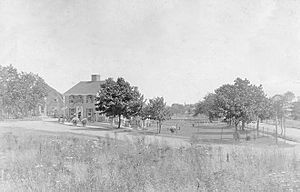General Glover Farm facts for kids
The General Glover Farm is a really old farmhouse from the 1700s. It sits on a 2.4-acre piece of land right where the towns of Marblehead, Swampscott, and Salem meet in Massachusetts. This historic farm has a long story, from being owned by someone loyal to the British king to becoming a home for a famous American general, and later a popular restaurant.
Contents
A Home Through History
The General Glover Farm has seen many changes over the centuries. It started as a farm and later became a well-known inn and restaurant.
Early Days and the Revolution
Before the American Revolution (the war where America became independent from Britain), the farm belonged to William Browne. He was a "Loyalist," which means he stayed loyal to the British king during the war. Because of this, the government of colonial Massachusetts took his property away. This was a common thing that happened to Loyalists during and after the war.
General John Glover's Retirement Home
After the American Revolution ended, a very important person bought the farm in 1782. This was General John Glover. He was a brave leader in the Continental Army during the war. General Glover had lived in Marblehead for a long time, but after his military service, he bought this farm to retire. He lived there until he passed away in 1797.
From Farm to Inn to Restaurant
After General Glover's death, his family eventually sold the farm. It kept being used as a farm for many years. Later, it was turned into the Glover Inn. An extra part was built onto the back of the old 1700s house, and many of the other old buildings on the property were used as part of the inn.
The Glover Inn welcomed guests until 1955. Then, in 1957, it reopened as the General Glover House Restaurant. A man named Anthony Athanas started this new restaurant. More additions were built onto the main house, creating many dining rooms and bars. These new areas were designed to look like a colonial inn, fitting the historic feel of the place. The restaurant was very popular for many years but eventually closed in the 1990s. The historic farmhouse and many of its original buildings are still standing today at 299 Salem Street.
Images for kids




